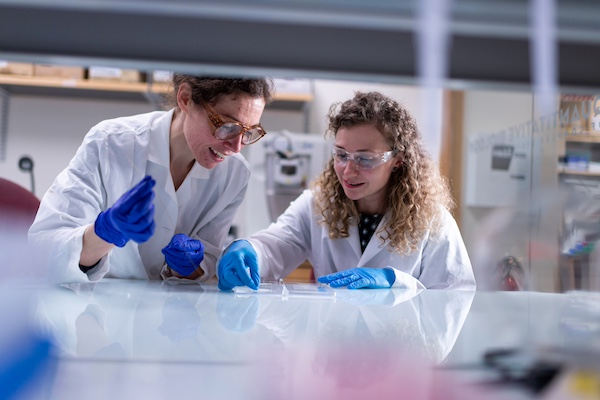A panel of virology and infectious disease experts came together for the Morgridge Institute’s Fearless Science Forum series on October 27 to discuss “Vaccines: Dispelling Myths and Making Informed Choices.”
Morgridge investigator Paul Ahlquist moderated the panel discussion, featuring: professor of pathobiological sciences Jorge Osorio, infectious disease physician Nasia Safdar, MD and pediatrician John Williams, MD.
The following is an abridged transcript of selected questions and key takeaways from the discussion. A recording of the webinar can be viewed in full above.
Opening Remarks

Paul Ahlquist: Thank you for joining us today for our panel discussion on vaccines, dispelling myths and making informed choices — a very timely topic in the midst of national controversies and shifting federal policies.
How are vaccines evaluated before and after approval? And are these approaches sufficient to ensure vaccine safety?
Nasia Safdar: Before a vaccine ever makes it into a human, there is an extensive, carefully curated process. It begins in the lab where you have to identify the right target to be able to focus on for a vaccine, to be able to demonstrate its safety and lack of toxicity in pre-clinical settings. And then it comes into human [trials] as Phase 1, followed by a Phase 2 and then a Phase 3.
And even after a vaccine is approved, once it has been demonstrated to be safe and effective, there is a post-approval continuous monitoring process to make sure that the whole idea of the benefits far, far outweighing the risks continues to be met.
Over the decades, millions of children have been vaccinated, some vaccine preventable diseases have been all but eliminated, and so I think that currently that, area of vaccinology is pretty clear in terms of its benefit.

How are the vaccine targets and schedules for childhood vaccinations chosen, and what assures that these childhood vaccines and their combinations and timings are appropriate?
John Williams: One is the fact that young immune systems are more immature and often need multiple doses of a vaccine. So, you know, one reason for that timing of getting a dose every couple of months is to boost their immune response. This is the way the immune system works.
Another is with specific diseases. The timing of when babies get infections — and many of the most serious infections like pertussis or whooping cough, bacterial meningitis, which is caused by several different kinds of bacteria — these occur they peak in infants and young toddlers. So if we waited until a child was two years old, we would be leaving them at risk all that time.
What about at the other end of life when people are becoming elderly, what happens to the immune system in that situation? And what would be the implications for vaccination?

JW: What happens is a phenomenon called, in a fancy medical term, immunosenescence, which just means the immune system is getting old and a little frail and like everything else, doesn’t work as well as it used to. So older adults, in recent years, people have done studies that have shown some that they don’t respond as well to standard vaccines, and vaccines are adjusted accommodate for that.
NS: For some of these conditions, we’ve been able to get around the immunosenescence of aging by raising the dose of the relevant vaccine.
PA: So at both ends of life, there are special considerations that parents and elderly people and perhaps their caregivers should be aware of.
Do vaccines still provide real benefits to individuals and society, or are vaccine-targeted diseases no longer real dangers? Have vaccines already eliminated the need for continued vaccine use?

Jorge Osorio: It’s very concerning that only five years after the COVID-19 pandemic, we’re questioning the value of vaccines. Overall, vaccines remain one of the most effective public health interventions that we have ever developed. There is data showing that we save at least 6000 lives per day, by the effects of vaccination, and this results in about two and a half to 5 million people per year that are saved from vaccines.
It’s also very concerning that, misinformation is also affecting the eradication programs that we have with some of these, infectious diseases.
Measles is a very highly contagious viral disease. Fortunately, we have a very effective vaccine. need about 95% herd immunity for this vaccine to be effective. So in the US, we have had a very successful vaccination program, and we eliminated measles since the year 2000.
But unfortunately, during the last five years, due to many factors, including misinformation, some of these states have dropped vaccine coverage, even as low as 80%. We have heard, the news this year about the significant outbreaks that we have in the US for measles. We have had more than 1500 cases in about 42 states in the country.
What is herd immunity and how does that relate to the vaccination status of a population as opposed to an individual?
JO: Basically, what we are talking about is how many people in your community needs to be vaccinated to avoid transmission. And there are different rates. There’s the more transmissible the pathogen is, the, in this case, measles, the higher herd immunity we need to have to stop transmission.
PA: If you achieve a sufficient level of vaccine-induced, immunity in the population, that even an unvaccinated person would be protected. So you’re talking about achieving a, reduced level of transmission that would even protect an unvaccinated person, is that right?
JO: That’s correct, because basically, there is no, possibility from the virus to spread significantly. So that will allow the community to be protected. I think that’s why we need to provide better information about the impact of vaccines and the need for vaccination in some of those communities.
PA: So the concept of trying to depend on herd immunity and, as it were, “freeloading” on the vaccinated population is particularly dangerous.
JW: I think people often feel like, “Well, you know, these diseases are gone. We don’t have to worry about it. If everybody else is vaccinated, I don’t have to.” And that works until it doesn’t. It’s like driving with your kid in the car without a seatbelt. If you said, I’ve driven with my kid in the car without a safety seat or seat belt and nothing’s ever happened… until it does.
How can we distinguish reliable information versus misinformation on vaccines?
NS: More recently it’s become increasingly hard to distinguish between the two because with the power of social media and the ability to post anything at any time on the internet, it becomes very easy for people to post things that have no basis in fact. And it’s difficult to distinguish because they’ve become increasingly sophisticated. Sometimes it’s not even people posting these things. Chatbots and the like that have been programmed to do so.
I think what people might want to do is to look for some trusted sources of information. And one idea might be to choose to go to websites that are populated in a reliable manner by organizations that are focused on patient safety and patient outcomes.
Ask the question of whether the person who’s presenting the information actually has a basis for making these claims. Just because somebody says something, of course, doesn’t mean it’s true.
Recommended resources
- Infectious Diseases Society of America (IDSA) information on immunizations and infectious disease
- Recommended immunization schedule from the American Association for Pediatrics (AAP) and the American Academy of Family Physicians
- American Health Insurance Plans industry organization vaccine coverage statement made during the new CDC advisory board meeting
- State of Wisconsin recommendations for vaccinations and COVID-19
- Vaccine Integrity Project at the Center for Infectious Disease Research and Policy (CIDRAP)
So, what about those recent changes and recommendations that came from the administration and the CDC?
JW: For many years now, measles, mumps, rubella and varicella (chickenpox) are given at the same time, combined into one. The recent change is recommending that kids under four can be immunized with those, but that it should be varicella and MMR separately — which is really problematic because they’ve been combined for so long. Many manufacturers may not make them separately. And most parents don’t want their kids to have to get multiple shots.
NS: I think there’s a common saying that we’ve all heard, which is that “vaccines don’t save lives, vaccinations save lives.” A vaccine sitting on a shelf is not going to do anyone any good. And that’s so we’ve recommended combination vaccines, to do it at birth — these are all meant to reduce the barriers to people to getting vaccinated.
Anything that undoes that is not going to be a good step in the future. When you make it harder for people to get the vaccine, should they choose to, it really does the whole population a disservice.
Are vaccines actually pushed by pharmaceutical companies and doctors because they’re big profit makers?
JW: This is this is a really common question that people have. I think the basic question of the value proposition of companies selling things, that’s a great question. We should be asking that. But the facts just don’t support that for childhood vaccines. And they never have.
We’ve heard a lot about vaccines directed against infectious diseases. Looking to the future, what new applications are in the pipeline?
JO: You may have heard about the mRNA vaccines from the Covid-19 pandemic. But the truth is that mRNA vaccines have been around for a while, and in fact, was cancer one of the first in the case, the first efforts that were done for mRNA vaccines. Ithink there’s where that there’s a lot of potential for future for many vaccines.
PA: Of course, one of the great strengths of messenger RNA vaccines is the ability to generate them quickly and for new and distinct targets. And in the case of cancer vaccines, in many cases, there would be a need to have a vaccine that is precisely targeted to an individual person’s cancer.
JO: We are going towards that field of personalized medicine where basically, there is no vaccines for mass population, but there’s a specific, issues or disorder that a person might have.
We have pretty strong efforts here at UW–Madison, in this regard as well.
What about broad spectrum vaccines?
JO: So basically we have seen, that pathogens tend to mutate and easily — change from two different strains or different clades. So broad spectrum vaccines is basically taking into account how these pathogens tend to change with time and trying to make a vaccine that has what we call broad protection, that if we have a new strain or a new variation of the pathogen, we still can have that protection.
PA: So the goal is to allow vaccines that we can only need to develop once and have good protection — a very promising area. And another illustration of a place where investments can be made with the potential for a tremendous payoff for society.
Watch the full recording of the webinar above.
